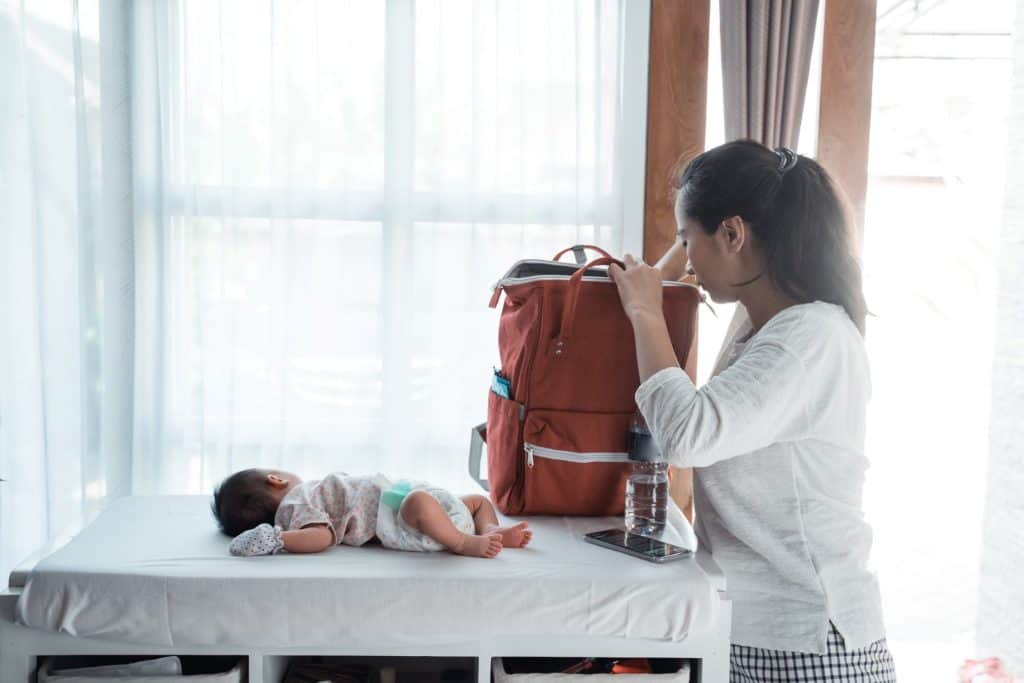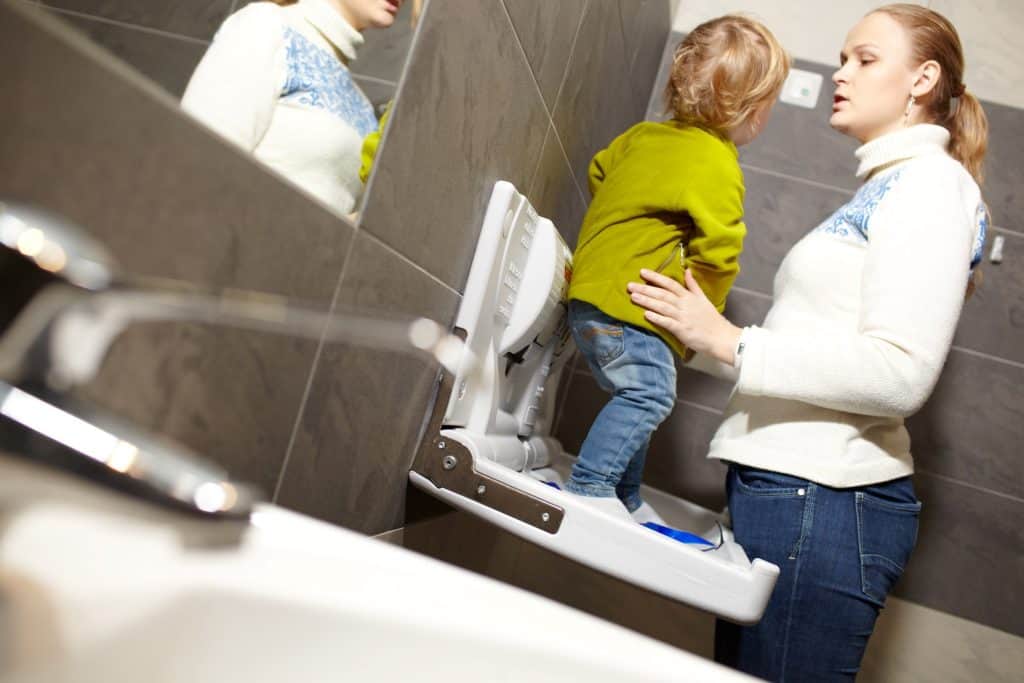Changing a baby’s diaper is messy, time-consuming, and exhausting at the best of times. It’ll rarely be the best of times. To boot, most babies hate diaper changes. They can go through 8-10 of them in a day, and every difficult instance will sap your patience.
It can be more than most parents can reasonably hope to manage. Fortunately, a few easy fixes can work wonders at mitigating the worst of your workload.
First off, minimize downtime by prepping everything you need in advance. Make sure the changing room is warm and cozy. Distract them with toys and talk for a smoother change.
Make sure their diaper is the proper fit and size for them. Minimize how long they need to spend lying down. Lastly, pick your diaper-changing moments with their comfort in mind.
Diaper changes aren’t fun for anyone, so focus all of your efforts on making it as quick and painless as possible. We’ll go over a few ways you can accomplish just that down below.
Baby Hates Diaper Changes? Try These Solutions:
1. Prepare All Your Changing Supplies Beforehand

Babies demand plenty of your limited time and attention. Good intentions won’t be enough – you need to be efficient with your care, minimizing needless distractions, delays, and waste.
Imagine having to change your baby’s diaper after they had a potty accident, only to realize their diapers, baby powder, wipes, and trash bag were all left in different rooms!
It would turn a routine procedure into a frantic scramble that was not only inefficient but completely avoidable. Babies need diaper changes at least eight times a day, and if every instance of that is this ineffectual you can’t hope to keep that pace up for long.
Preparation is a critical part of parenthood! How you’d prepare for diaper changes differ on whether you’re doing it at home or somewhere else.
At Home
Your first order of business is setting up a designated changing room in your home. This places everything you need in an accessible environment while giving you a routine to work with.
Pee-proof this changing room! Look around for waterproof mattress protectors: these reduce the risk of unwanted absorption and stain accumulation. It also has the added effect of protecting against other contaminants such as saliva or spilled baby formula!
A mattress protector might seem like a steep, unneeded investment, but less potty spillover means less time and money spent on disinfection and laundry. It’s well worth the expense.
You might consider using cheaper alternatives such as plastic sheeting for pee-proofing purposes, but we’d strongly advise against it for a few reasons. It’s uncomfortable to the touch – especially for your baby’s sensitive skin – and tears too easily to serve in any dependable role.
Outside

You absolutely need to prep a diaper bag for on-the-go diaper changes. Make sure to fill it with everything you needed in your changing room: clean nappies, wipes, trash bags, and baby powder.
Always keep it topped off – you won’t be able to restock quickly during a potty emergency.
Keep that bag close to your infant, as accidents have a habit of cropping up at the most inconvenient times. You could tie it around your handbag to make it easier to haul around. You could also tuck it into their stroller carriage while out on a walk with them.
The bottom line here is that the diaper bag needs to be within arm’s reach of you at all times.
A spare change of clothes – for them AND you – would be a smart addition to your diaper bag. Some potty messes can leak past the diaper, soiling outfits in the process. As a parent, you need to get used to hoping for the best, but thoroughly preparing yourself for the worst.
2. Keep Your Baby Warm
It’s important to recognize that babies have poor thermoregulation – especially compared to adults. They could find themselves chilled and shuddering at temperatures parents might not even recognize as problematic, and this exposure could lead to all kinds of illnesses.
Prioritize minimizing the time your baby spends exposed to the elements. Think of ways to keep them warm for the period they need to stay exposed.
Start by making sure there aren’t any drafts or cold air blowing into the changing room – close any exposed windows and turn off running fans in the vicinity. If the room is airconditioned though, we’d recommend leaving to change them somewhere else entirely.
Give them something to snuggle up to. A towel, small blanket, or even a plushie would do just the trick. Doing this also has the added benefit of grabbing their attention, making them less likely to disrupt your diaper-changing efforts.
3. Give Them Toys To Keep Their Hands Occupied
Your baby might have a habit of tugging at your hands or their nappy during diaper changes. This not only makes the whole ordeal more tedious but even runs the risk of letting the messy contents of their diaper leak out!
A few toys to occupy their attention could make all the difference, keeping their roaming hands from making a mess of things. You could also distract them by playing a video on your phone.
We’d recommend using small toys, such as dolls or fidget cubes, for this purpose. If you get your baby something too big, they might hold it low enough to get in your way. You want something compact but easy to clean.
Steer clear of soft toys like clay, putty, or slime for the sake of hygiene – you really don’t want to run the risk of cross-contamination here, especially that close to the danger zone!
It’s worth setting aside a few toys specifically for diaper changing time. Diaper changing time used to be something entirely negative in your baby’s eyes, explaining their frustration. Adding positive experiences could help change their minds, so to speak.
It lets them reorient how they view diaper changing time: it’s not just a time where they’re forced to lie down, bored, but an opportunity to play with toys they can’t encounter otherwise!
If you’re lucky, they might even forget about their hatred of nappy changing time entirely!
4. Talk To Them Throughout The Changing Process

Talking to your baby helps keep them distracted, making them less likely to act out in problematic ways. It also has the added benefit of improving their language development and cognition, making it a win-win for everyone involved!
A good starting point here would be sharing how your day went with your baby. It’s a little odd at first, chatting with someone who doesn’t talk back, but you get used to it quickly. A little awkwardness is to be expected at first, but practice does make perfect.
Talk about your day: how it went, who you spent time with, etc. Changing a diaper shouldn’t take more than a couple of minutes, so you’re unlikely to run out of material. Sharing how your day went could also be a cathartic experience for you.
Some people struggle with being this open – even towards someone who can’t even understand. It’s something that varies between people, but fortunately, you still have some options here.
If you’re really starved for topics, why not try rattling your routine off? Describe the diaper change to your baby, step-by-step, as you go along. This benefits everyone here.
Babies love the sound of their parent’s voices, and this routine gives them something to focus on. It distracts them, making them less likely to act disruptively through the changing process.
For parents, reading your routine almost serves as a mantra. It helps you drill the procedure’s steps into your head, making you more aware and efficient with what you need to accomplish.
5. Make Sure The Diaper Is A Good Fit For Them
Another reason your baby hates diaper changes could be because they aren’t comfortable with how they fit. Your baby’s diapers may be undersized or improperly worn.
Most commercial diaper brands come with general guidelines on the label. These usually work by listing infant weight ranges and then matching them with appropriate diaper sizes. They’re great for approximations, but you shouldn’t depend on them without checking for yourself.
Signs of bad fits include redness, skin irritation, or chaffing localized to the area near the diaper cuffs and waistband. You can check if it’s too tight by trying to stick a finger under your baby’s diaper waistband. The right fit should leave you with a little slack to wiggle your finger around.
If your finger is being compressed by the diaper waistband, it’s much too small for your infant. Get bigger diapers for them on your next shopping trip.
Don’t forget that you can always tuck in or trim down oversized diapers. You could also just store them away until your baby begins to grow into them. You can’t refit undersized diapers.
If you have too many undersized diapers, it’s better to return them to the store or sell them to another family rather than forcing your baby to use them all. Doing this will only make your baby hate diaper changing time even more.
6. Minimize The Time They Spend Lying Down
Babies love exploring the world around them, using their hands, feet, and senses to experience it all. Restricting them to one spot deprives them of that, leading to a lot of potential frustration.
As much as possible, minimize how long your baby has to lie down during the changing process. Infants prefer being standing or seated over lying down, and they’ll likely be a lot more cooperative if you make things comfortable for them.
It’s also a good habit to develop. Changing areas outside of your home can’t be fully sanitized – minimizing your baby’s contact time with those surfaces is the next best thing.
Standing Diaper Changes

Once your child is a bit older, you may want to consider switching them to standing diaper changes.
Standing diaper changes have your infant upright, allowing them to help you through the diaper change by shifting their bodies to more convenient positions.
It also has the added boon of reducing your baby’s exposure time to their changing surface and being more hygienic in the long run.
Standing diaper changes aren’t always intuitive for your baby, so try practicing in the comfort of your own home – preferably with an unloaded diaper.
Install a low bar in your changing room to give your infant something to latch onto, then practice gently guiding their limbs through the needed motions.
7. Pick Your Moments
Avoid changing your baby’s diapers while they’re in the middle of playtime. If you must, at least let them keep their toy (or give them something else to play with).
Avoid changing them just before feeding time as well – a hungry baby is a cranky baby. A cranky baby will fight you tooth-and-nail on pretty much everything. It’s best to change their diaper a little earlier than you planned to avoid overlapping it with their meal time.
Babies go through over half a dozen diapers a day, at minimum, so you’re bound to encounter a few inconvenient changing windows. You won’t always be able to put off a diaper change, but you can always put in the effort to be considerate of their current needs.
Final Thoughts
Most babies hate diaper changes, but a little bit of mindfulness, timing, practice, and preparation can turn this task into something much more manageable. Knowing is half the battle, so all that’s left now is the follow-through!